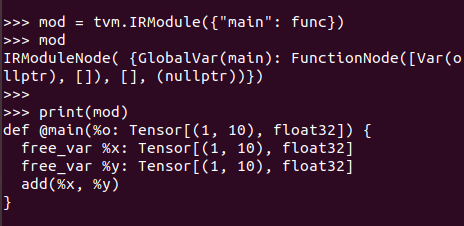Thank you @MarisaKirisame
Let say I have following function, and I am wondering which python object is the graph representation?
My understanding is that module is consists of functions, and module is the graph representation.
def example():
shape = (1, 10)
dtype = 'float32'
tp = relay.TensorType(shape, dtype)
x = relay.var("x", tp)
y = relay.var("y", tp)
out = relay.var("o", tp)
z = relay.add(x, y)
func = relay.Function([out], z)
mod = relay.Module({"main": func})
The outputs are here:
>>>z
CallNode(Op(add), [Var(x, ty=TensorType([1, 10], float32)), Var(y, ty=TensorType([1, 10], float32))], (nullptr), [])
>>>func
FunctionNode([Var(o, ty=TensorType([1, 10], float32))], (nullptr), CallNode(Op(add), [Var(x, ty=TensorType([1, 10], float32)), Var(y, ty=TensorType([1, 10], float32))], (nullptr), []), [], (nullptr))
>>>mod
IRModuleNode( {GlobalVar(main): FunctionNode([Var(o, ty=TensorType([1, 10], float32))], (nullptr), CallNode(Op(add), [Var(x, ty=TensorType([1, 10], float32)), Var(y, ty=TensorType([1, 10], float32))], (nullptr), []), [], (nullptr))})


